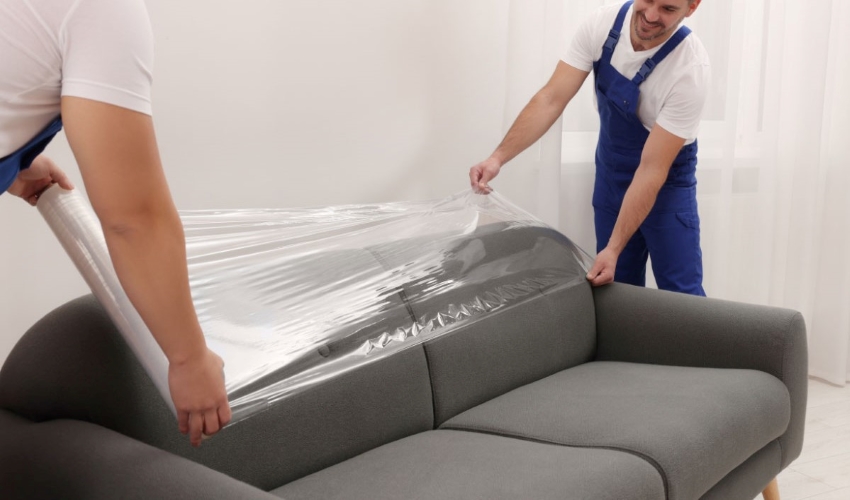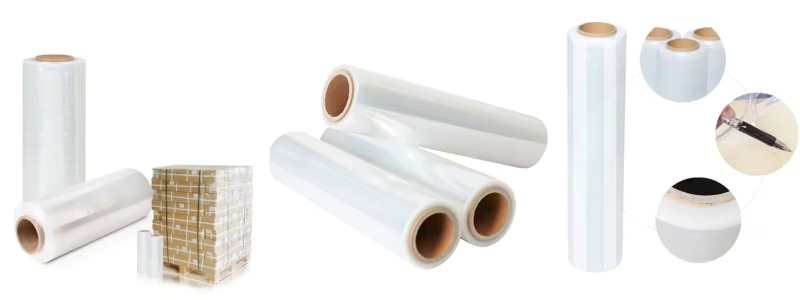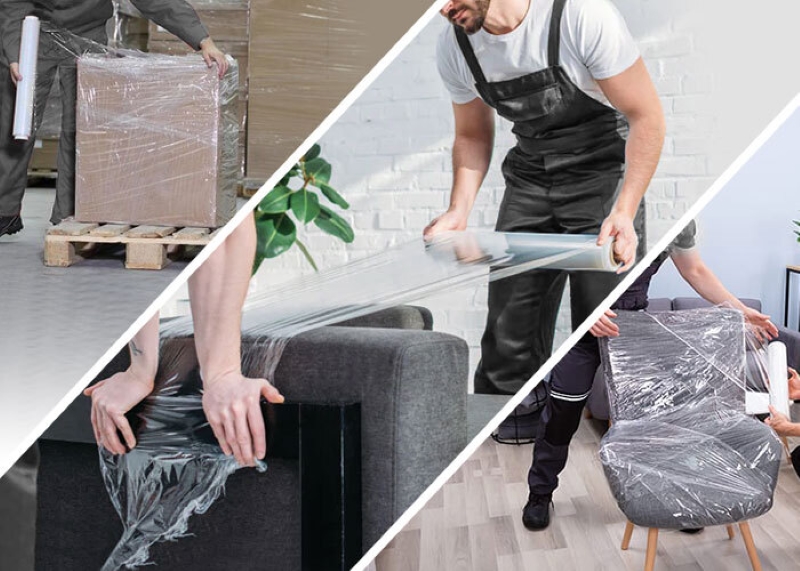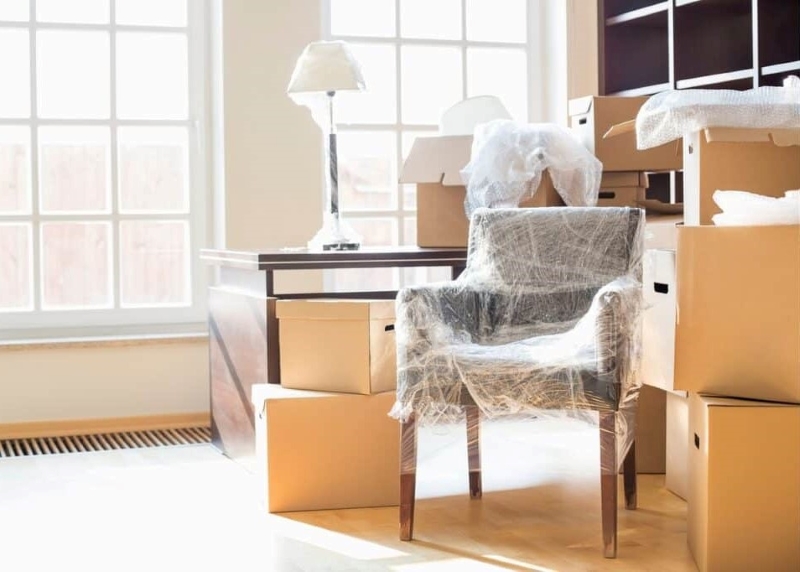
Furniture wrap is a versatile protective material designed specifically for safeguarding items during moving and storage. This type of wrap, is usually used along with hand stretch film, which is essential for preventing scratches, dust, and moisture from damaging your furniture. Made from durable plastic, hand stretch film clings tightly to various surfaces, ensuring that your items remain secure throughout the process. Its importance cannot be overstated, as it not only preserves the condition of your belongings but also makes the moving experience more efficient. By using furniture wrap, you can easily bundle and protect multiple pieces, keeping everything in place and reducing the risk of damage during transit. Whether you are relocating or storing, furniture wrap is an indispensable tool. Furniture wrap is a versatile plastic material that secures and protects furniture from scratches and damage during moving or storage.
Why Choose Our Stretch Film Over Competitors?

Decorative furniture wrapper offers a unique blend of style and protection, making it an excellent choice for enhancing the appearance of your furniture while keeping it safe. The aesthetic advantages of using furniture wrap decorative are significant, as it allows for customization and personalization in a way that traditional covers cannot.

Key benefits include:
By incorporating furniture packing wrap decorative into your home, you not only protect your investments but also elevate the overall aesthetic of your living space.
Wrapping wood furniture requires special attention to detail to ensure that the items remain protected without incurring damage. Wood is susceptible to scratches, dents, and moisture, making the choice of wrapping materials and techniques crucial.
By following these best practices for furniture wrap, you can help ensure that your wood furniture remains in pristine condition during moving or storage. Properly wrapped pallet protection not only enhances the durability of the furniture but also maintains its aesthetic appeal over time.
When searching for furniture wrap, locating a nearby supplier can save time and ensure that you get the right product for your needs. Here are some effective tips for finding furniture wrap in your local area.
By following these tips, you can effectively locate furniture wrap near you, ensuring you have the right supplies to protect your furniture during moving or storage.
Using plastic wrap, specifically designed for moving furniture wrap, offers numerous benefits that can enhance the efficiency and effectiveness of your packing process. Here’s an overview of its advantages and tips on how to use it effectively for securing furniture during relocation.

By following these practices, you can maximize the effectiveness of using plastic wrap for moving furniture, ensuring that your belongings are well-protected and organized during the relocation process.
Shrink wrap is a popular choice for protecting furniture, often referred to as furniture wrap, offering a range of benefits that make it ideal for both storage and moving. Understanding how to effectively use furniture wrap can significantly enhance the safety and integrity of your furniture during transport or while in storage.
Shrink wrap is a versatile plastic film that, when heated, shrinks tightly around the object it covers. This snug fit provides several advantages for protecting furniture:
By following these guidelines, you can maximize the protective benefits of shrink wrap, ensuring that your furniture remains safe and intact during storage or moving.
When it comes to storing furniture for an extended period, using furniture wrap effectively is crucial to maintaining its condition. The right techniques can help ensure that your items remain in pristine condition, free from damage due to moisture, pests, and dust.
Moisture control and pest protection are essential considerations for successful long-term storage.
By following these tips and techniques for using furniture wrap for storage, you can ensure that your furniture remains safe, dry, and in excellent condition throughout its time in storage.
Finding the right furniture wrap manufacturer involves evaluating several key factors to ensure quality, reliability, and value. Below are detailed points and sections to guide your search:
By focusing on these sections—product quality, pricing, customization, reputation, customer service, and delivery—you can confidently choose a furniture wrap manufacturer that best suits your needs.
PWP Stretch Film offers numerous advantages as a furniture wrap, ensuring optimal protection and ease of use for moving and storage:
By choosing PWP Stretch Film as your furniture wrap solution, you benefit from a combination of quality, efficiency, sustainability, and customer satisfaction that sets us apart in the packaging industry.
When selecting furniture wrap for moving, choosing the right size ensures proper coverage and protection for your items. Furniture stretch wrap is available in multiple sizes, with three common widths that cater to various moving needs:
Why It’s Suitable: Ideal for bundling smaller furniture parts, such as chair legs, cabinet doors, or loose components. The compact size allows for precise wrapping and prevents pieces from shifting during transport.
Furniture Type: Chairs, small tables, detached shelves, and accessories like lamps or stools.
Why It’s Suitable: A versatile size for wrapping medium to large furniture items. It balances coverage and maneuverability, making it easy to wrap surfaces tightly while ensuring protection.
Furniture Type: Desks, cabinets, dressers, nightstands, and cushioned chairs.
Why It’s Suitable: Best for large furniture or bulky items as it provides wide coverage, reducing the time needed to wrap surfaces. Its stretchability secures large furniture parts and prevents scratches, dust, and moisture exposure.
Furniture Type: Sofas, mattresses, wardrobes, dining tables, and sectional couches.
Furniture wrap made from stretch film adheres securely without adhesive, ensuring it doesn’t damage surfaces or finishes. Its elasticity allows for tight wrapping, holding furniture components together and providing a protective barrier against scratches, dirt, and moisture. It’s lightweight, easy to apply, and highly effective for both short and long-distance moves.
By using the appropriate furniture wrap size, you can protect your furniture effectively, making the moving process safer and more efficient.
Furniture wrap is a specific type of stretch wrap designed to meet the unique needs of moving and protecting furniture, and it differs from general-purpose stretch wraps in several key aspects:

Material Strength and Thickness
Furniture Wrap: Typically thicker and more durable, designed to handle the sharp edges, heavy weight, and irregular shapes of furniture without tearing. It provides extra protection against scratches, moisture, and dirt during transport.
Other Stretch Wraps: General stretch wraps, such as those used for pallets or packaging, may be thinner and designed primarily for bundling lightweight or uniform items. They are less suited for protecting furniture surfaces.
Elasticity and Cling
Furniture Wrap: Has superior elasticity, allowing it to tightly secure furniture parts like doors, drawers, or cushions without adhesives. It clings firmly while conforming to irregular shapes, preventing shifting during movement.
Other Stretch Wraps: While standard stretch wraps do have some stretch, this characteristic can make them less reliable for preventing shifting during transportation, as the material may loosen over time, reducing its ability to securely hold items in place.
Surface Protection
Furniture Wrap: Specifically formulated to protect delicate or finished surfaces like wood, upholstery, and glass. It leaves no residue, ensuring the furniture remains clean and undamaged.
Other Stretch Wraps: Regular wraps may not provide adequate protection for fragile surfaces and can sometimes leave marks or fail to shield against scratches.
Application Convenience
Furniture Wrap: Designed for ease of use during moving, furniture wrap often comes in larger rolls with convenient dispensing tools for quick and efficient wrapping.
Other Stretch Wraps: General-purpose wraps may come in smaller, less ergonomic sizes, making them harder to apply on large furniture items.
Furniture wrap stands out due to its durability, elasticity, and surface protection, making it the ideal choice for moving heavy, delicate, or irregularly shaped furniture while ensuring it arrives at its destination undamaged.
To make furniture wrap particularly suitable for moving, it must possess specific features and advantages that ensure effective protection and ease of use. Below are the essential attributes:
High Durability and Tear Resistance
Moving involves friction, sharp corners, and heavy handling. Furniture wrap must be thick and strong to resist tearing or punctures, ensuring reliable protection throughout the move.
Superior Elasticity and Cling
Furniture wrap should stretch and cling tightly to items without adhesive. Its elastic properties allow it to secure furniture parts like drawers, doors, and cushions, preventing shifting or opening during transport.
Non-Adhesive Surface
The wrap must cling naturally without leaving sticky residue on furniture surfaces, ensuring no damage to wood finishes, upholstery, or glass components.
Moisture and Dust Resistance
Furniture wrap acts as a protective barrier against moisture, dirt, and dust, keeping furniture clean and dry during transport or storage.
Lightweight and Easy Application
A good furniture wrap should be lightweight, easy to handle, and quick to apply with convenient dispensing options, reducing packing time and effort.
Versatile Sizing
Furniture wrap should be available in multiple widths (5-inch, 15-inch, and 20-inch rolls) to accommodate different furniture sizes, from small chairs to large sofas and tables.
Protects Furniture from Damage
By shielding furniture from scratches, dents, and abrasions, furniture wrap ensures items remain in pristine condition during transport.
Secures Loose Parts
Furniture wrap effectively holds furniture parts, such as drawers, doors, and detachable legs, in place, preventing accidental movement or loss.
No Mess or Residue
Unlike adhesive tapes, furniture wrap protects surfaces without causing damage or leaving sticky residues, making it safe for delicate finishes.
Cost-Effective Solution
Furniture wrap is an affordable packing material that provides maximum protection, reducing the risk of costly repairs or replacements.
Ideal for All Furniture Types
Suitable for wood, metal, glass, and upholstered furniture, furniture wrap is versatile enough to protect various items, from small chairs to large wardrobes.
By combining durability, elasticity, and surface protection, furniture wrap provides a reliable, mess-free, and cost-effective solution for moving furniture securely and efficiently.
The cost of wrapping furniture can vary significantly based on several factors, including the size and type of furniture, the material used for wrapping, and whether you hire professionals or do it yourself. On average, if you opt for professional wrapping services, you might expect to pay between $200 and $500 for a standard move, depending on the volume of furniture being wrapped. If you decide to wrap your furniture yourself, purchasing furniture wrap rolls can cost anywhere from $15 to $50 for a roll, depending on the size and thickness. Additionally, you may need to factor in other supplies such as tape and protective padding, which can add to the overall cost. It’s always a good idea to compare prices and consider the value of protecting your furniture against damage during transit or storage.
The best material for wrapping furniture depends on the specific needs of your items. Generally, high-quality plastic stretch wrap is favored for its versatility and effectiveness in protecting furniture. This type of wrap clings tightly to surfaces, creating a protective barrier against dust, moisture, and scratches. Bubble wrap is also an excellent option, especially for delicate or valuable pieces, as it provides additional cushioning. For wood furniture, using furniture blankets or moving pads can be beneficial, offering both protection and insulation against temperature changes. If you are storing furniture long-term, consider using shrink wrap, which provides a secure, tight fit. Ultimately, the best material will depend on the level of protection needed and the conditions in which the furniture will be stored or transported.
Furniture wrap serves multiple purposes, primarily protecting furniture surfaces during transportation, storage, or renovation projects. It shields items from dust, dirt, moisture, and minor damages like scratches, dents, or stains. The wrap acts as a barrier that preserves the finish of delicate materials, such as wood, glass, or upholstery, ensuring they remain in good condition. Furniture wraps are commonly used when moving, as they secure components like drawers, doors, or cushions, preventing them from shifting or opening unexpectedly. In commercial settings, wraps can also provide temporary aesthetic updates or branding opportunities. Different materials, such as plastic shrink wrap, bubble wrap, or adhesive vinyl wraps, cater to varied needs—offering flexibility for both protection and design. Whether for short-term moving purposes or long-term coverage, furniture wraps are essential tools for maintaining the integrity and appearance of valuable furniture pieces.
Yes, you can use vinyl wrap on furniture as a cost-effective and versatile way to refurbish or customize surfaces. Vinyl wraps are self-adhesive sheets that can be applied to various furniture materials, including wood, laminate, metal, or plastic. They come in numerous finishes, such as matte, gloss, woodgrain, or metallic, allowing you to transform furniture to match your preferred style or decor. Applying vinyl wrap to furniture is an excellent alternative to painting or refinishing, as it’s less time-consuming, relatively mess-free, and reversible if you decide to change the look later. Vinyl wraps are also durable and easy to clean, making them suitable for high-traffic furniture like cabinets, tables, and desks. However, proper surface preparation—cleaning and smoothing—is key to achieving a long-lasting and seamless finish. With careful application, vinyl wraps offer an affordable way to give furniture a fresh and modern update.
To wrap furniture for moving, begin by cleaning the surfaces to remove dust or dirt that could cause scratches. For upholstered items, ensure they are dry to prevent mold or odors. Start by disassembling any detachable parts like legs, shelves, or cushions. Use moving blankets or padding to cover large surfaces, securing them with packing tape or plastic wrap to prevent shifting. For added protection, wrap furniture in plastic shrink wrap, tightly sealing corners and edges to avoid scuffs, moisture, and dust. Fragile areas, such as glass panels or mirrors, should first be covered with bubble wrap and cardboard before applying shrink wrap. For wooden furniture, avoid using adhesive directly on the surface to prevent damage. Label each wrapped item or part for easier reassembly at your destination. Proper wrapping ensures that furniture remains protected during transport and reduces the risk of damage during handling and transit.
The cost of shrink wrap varies based on material quality, size, and intended use. For moving and furniture protection, rolls of plastic shrink wrap are commonly available in different widths and lengths, ranging from 5 to 20 inches wide. On average, a standard 1,000-foot roll of stretch film costs between $15 and $50, depending on thickness and durability. Premium-grade shrink wraps, designed for heavy-duty use or industrial applications, can cost up to $80 or more per roll. If you require pre-cut sheets or larger rolls for wrapping bulky furniture or commercial items, the price increases accordingly. Factors like UV protection, puncture resistance, and eco-friendly materials can also influence pricing. For smaller projects, budget-friendly options like mini rolls are available for as little as $10. Overall, shrink wrap remains an affordable and practical solution for protecting furniture during moves, storage, or renovation projects.

My name is James Thompson, and I’m the editor of this website dedicated to Stretch Film, Pallet Wrap, and Stretch Wrap products.
My passion for packaging began when I noticed the challenges companies face in securing their products efficiently for transportation and storage. This inspired me to delve deep into the world of stretch films and pallet wraps, exploring the latest technologies and best practices.
I aim to provide valuable insights, practical tips, and up-to-date industry trends to assist you in making informed decisions. Whether you’re a small business owner or part of a large corporation, my goal is to support you in optimizing your operations and ensuring your products reach their destination safely.
Thank you for visiting, and I look forward to accompanying you on your journey toward better packaging solutions.
Comments are closed